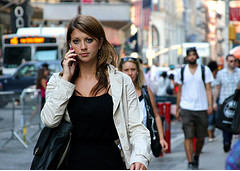San Francisco Backs Off On Law Requiring Retailers To Post Info On Cell Phone Radiation
Back in 2011, the city of San Francisco rustled up an ordinance that would require cell phone companies to post information telling consumers about the potential dangers of radiation in retail stores. The industry fought back, claiming the law violated its free-speech rights, and after a court held up an injunction against the law, the city has decided to throw in the towel.
According to the 2011 law, retailers selling cell phones and smartphones would have to alert consumers to the potentially cancer-causing radiation emitted by such devices. It would have required retailers to post notices stating that World Health Organization cancer experts have deemed mobile phones “possibly carcinogenic,” a finding noted in this Consumer Reports article from 2011.
The city’s Board of Supervisors voted to settle the lawsuit with the Cellular Telecommunications Industry Association — which includes heavy hitters like Verizon Wireless, AT&T, Samsung and Apple — by agreeing to accept a permanent injunction against the right-to-know ordinance.
If the ordinance had gone into effect, the CTIA said it would mislead consumers about the risks posed to their health. The CTIA argued that all phones sold in the United States already have to be tested to ensure that their radiation levels fall within the “safe” limits set by the Federal Communications Commission.
And besides, opponents of the ban argued, the levels of radiation people expose themselves to could differ based on individual cell phone use. The FCC is currently considering re-assessing those limits, as they were first set in 1996.
However, advocates of the ordinance point to various studies that say the ill-health effects of radiation from cell phones are very real. For example, an article in the journal Electromagnetic Biology and Medicine noted in 2011 that the FCC’s limits, known as Specific Absorption Rate, do “not adequately protect” most people who use cell phones, especially children who absorb more cell phone radiation than adults.
Because the city lost an appeal last year in a federal court that held up the injunction, San Francisco’s Deputy City Attorney Vince Chhabria said going to trial would be rough. And if the city lost, it’d have to fork over as much as $500,000 in attorney’s fees.
“I think the legal reality is that if we don’t approve the settlement, we’re talking about having to pay $500,000 in legal fees,” said Supervisor David Campos on that point.
NOTE: An earlier version of this post incorrectly characterized the warnings as labels or stickers that would placed on phones. The story has been edited to reflect that the warnings were to be posted notices, including information for consumers from the World Health Organization’s facts on cell phone radiation and its potentially harmful health effects, as well as suggestions for ways consumers can reduce exposure.
San Francisco surrenders in fight over cell phone warnings [Reuters]
Want more consumer news? Visit our parent organization, Consumer Reports, for the latest on scams, recalls, and other consumer issues.


